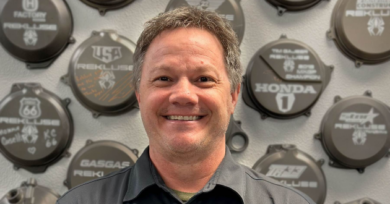Mar. 10, 2008 – Defending your product turf
By Steve Bauer
Managing Editor
Walking the floors at major trade shows, it’s not uncommon to see several products that look strikingly similar to one another. It’s a growing trend in the industry, and one that has manufacturers wondering whether they should invest the time and money to defend their products, and the best route to take to ensure justice is served on an infringing company.
T. Earl LeVere, a partner in the Columbus, Ohio, based law firm of Schottenstein, Zox and Dunn Co., LPA, specializes in intellectual property rights and has been involved with the subject for 14 years as an attorney and for several years before then while working in the music industry.
LeVere says problems of patent and trademark infringement are rampant in several industries in the United States and overseas but says manufacturers — especially those who are smaller and don’t necessarily have the revenue to take their fights to court — have several viable options available to them for protecting their original products or ideas. Whether it’s a phone call that might lead to a licensing agreement, a cease and desist letter or full litigation, a large majority of infringement cases can be resolved regardless of the manufacturer’s size.
Quick response is key
The first thing LeVere says any manufacturer must do is stay diligent about what products they are producing that might be subject to copycatting, and the faster they can catch a company copying your product, the better results they’ll have.
“You want to collect as much information as you can about who the retailer is, what the source is, where the product is made and how it gets into the United States,” he said. “If you can get photos that’s great, because if you can do it that will raise some eyebrows once you get to a litigation standpoint.”
LeVere says to also get a hold of any copies of brochures or other collateral the person is offering or the seller has, such as order information. It’s also important to find out exactly where they’re selling the product.
“This is important, especially if it’s in your home state,” he said. “If you end up going into litigation, you’re going to want to be in your neck of the woods since it’s less expensive and more convenient. But you can’t necessarily sue everybody everywhere, so you want to find out if the person you want to go after is actually selling product in a state you want (the court case) to be in.”
Once you suspect your patent is being infringed upon, LeVere says it’s critical to decide whether your patent covers what the company is copying.
“The real question when looking at supposed knockoffs is how does the accused product compare to the patent?” He said. “Sometimes a patent might not cover what a client is making or selling, and if that’s the case, there’s probably no point in pursuing it further.”
If the case does look good, LeVere recommends one of two courses of action: a cease and desist letter, or filing a lawsuit without serving it on the defendant.
“In a case where we think the other side is going to respond pretty aggressively, I will recommend filing a lawsuit in our home state first, but not serving it on the defendant, and then sending the cease and desist letter,” he said.
LeVere says the reason for doing that is it prevents the person who gets the letter from filing their own lawsuit in whatever state they’re in asking for what’s called a declaratory judgment, which is a federal statute that allows a person accused of infringement to go to a court and ask it to resolve the question of infringement.
“A declaratory judgment lets a person who normally would be a defendant go into court as a plantiff,” he said. “It’s a tactical maneuver that companies on the receiving end of a cease and desist letter can use to try to get the case tried in their own back yard, and it can be a big hit to your attempt to stop them from copying your product.”
International action
Because patents are country specific, LeVere says it’s nearly impossible from stopping companies from other countries from producing and selling your product in their home country. But U.S. law has strict enforcement laws that take hold once that company tries to sell that product on American soil.
“If you’ve got a U.S. patent and people are knocking off your product in China, you typically can’t stop it until they bring them into the U.S.,” he said. “Likewise, if someone acquires a patent in China and wants to sue you for infringing their Chinese patent, their patent has no strength in the U.S. But where that could be a problem is if you decide to manufacture and distribute your product in China or somewhere else, and there’s already a patent in place there, you might have a hard time fighting a manufacturer there.”
LeVere suggests that anytime you plan to apply for a patent for a new product, think about whether you might want to market it internationally sometime down the road, as that’s the time you should be applying for international patents, as well.
Is it worth the fight?
LeVere says the toughest question, even if you have a solid case, is whether it’s worth your time and money. He says important aspects to consider are how much you have invested in your product in terms of development, marketing and distributorships; what your sales numbers are; and whether you think this product has some longevity to it. Another big part of the equation is whether this product is a large part of your portfolio, and what percentage of your business does it represent?
LeVere says sometimes the answer can come down to what the retail price of the product is, and whether you’ll get your money’s worth in the end.
“I had a great case that was a dead bang winner for a client, but the problem was that retail it was a $28 part, and the other company didn’t sell a lot of them,” he said. “The measure of damages is typically a reasonable royalty, lost profits or the infringer’s profits. And in this particular case, even if that client got the full retail price for every one of the products the other company sold, it ended up being less than $100,000. At that point you really have to think, fees can be expensive, the other company is going to put up a heck of a fight, what’s it worth?”
LeVere says if you can get your attorneys fees paid and the other company has the money to pay them, it makes the decision easier to pursue the infringing company, because for intellectual property cases attorney and court fees can soar.
“Sometimes even if there’s not a big pot of gold at the end of the rainbow, one of the remedies you can get is in some cases what is the most important remedy to a client, and that’s an injunction,” he said. “It’s an order from the court telling whoever it is to stop selling, distributing or manufacturing your product. That’s a powerful remedy, and sometimes it’s important just from a company perspective to go after someone because the infringement problem isn’t necessarily limited to that one company you’re going after.”
Weigh your options
LeVere says the most important thing to remember for anyone considering fighting an patent infringement is you always have the option to start the process and stop it later.
“You can try and get these issues resolved without spending a ton of money, and there are things you can do short of litigation that might have good business results that aren’t too expensive,” he said. “Maybe a simple phone call will do, or a letter from a lawyer, and in some cases I’ve seen companies come to a licensing agreement on a product. But unfortunately there are cases where you might need to go after somebody and enforce your product, especially if it’s a core part of your business.”
For those who don’t have patent protection, LeVere says it’s vital to think about applying for a patent every time a new product is manufactured, because it’s an uphill fight without one. He does add, however, that there are several insurance companies available that can offer protection to smaller manufacturers that don’t have patent protection.
“There certainly are companies out there that offer insurance to protect against knockoffs, whether you have a patent or not,” he said. “The purpose of it is to both protect the insured from accusations of infringement, and also to go after people who infringe your products. And there are some cases where that’s a good thing to have.”
For questions or concerns regarding intellectual property matters, call T. Earl LeVere at 614/462-1095, or e-mail him at elevere@szd.com.








